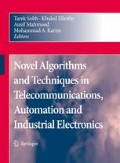In this paper we propose light-weight-agent as an efficient and effective tool for implementing data communication network bandwidth optimization and response time. The routing model for the agents is based on TSP algorithms. Performance comparison was carried out among RPC, Single Mobile Agent and tiny agents otherwise referred to as lightweight agents on the basis of bandwidth usage and response time. The performance evaluation shows the superiority of lightweight agents over the other schemes in terms of bandwidth usage and the response time.
Access this chapter
Tax calculation will be finalised at checkout
Purchases are for personal use only
Preview
Unable to display preview. Download preview PDF.
References
K. Qureshi and H. Rashid: A performance Evaluation of RPC, JAVA RMI, MPI and PVM . Malaysian Journal of Computer Science vol. 18 (2): 38-44, 2005.
R.J. SouZa and E.E Balkovich Impact of hardware interconnection structures on the performance of decentralized software Proceedings of the 8th annual symposium on Computer Architecture pp. 357 - 365, 1981.
M. Blocksome , C. Archer, T. Inglett, P. McCarthy, M. Mundy, J. Ratterman, A. Sidelink, B. Smith, G. Almasi, J. Castano, G. Lieber, J. MOreira, S. Krishnamoorthy, V. Tipparaju, and J. Nieplocha Blue Gene system software—Design and implementation of a one-sided communication interface for the IBM eServer Blue Gene® supercomputer Proceedings of the 2006 ACM/ IEEE conference on Supercomputing pp. 120-135, 2006.
A. Bieszczad, B. Pagurek, and T. White Mobile Agents for Network Management IEEE Communication Surveys. Available at www.comsoc.org/ pubs/ surveys [Aug. 10, 2006]
K. Boudaoud andZ. Guessoum A Multi-Agents System for Network Security Management. Proceedings of the IFIP TOS WG6.7 Sixth International Conference on Intelligence in Networks: Telecommunication Network Intelligence pp. 407-418, 2000.
A.S. Torrellas Gustavo and A.V. Vargas Luis Modeling a flexible Network Security Systems Using Multi-Agent Systems: Security Assessment Considerations. Proceedings of the 1st International Symposium on Information and communication technologies pp. 365-371, 2003.
M. F. De Castro, H. Lecarpenttie, L. Merghem and D. Gaiti An Intelligent Network Simulation Platform Embedded with Multi-Agents Systems for Next Generation Internet. Telecommunications and Networking-ICT pp. 1317-1326, 2004.
N. Rouhana and E. Horlait Dynamic Congestion Avoidance Using Multi-Agents Systems . Proceedings of the third International Workshop (NATA 2001) on Mbile Agents for Telecommunication Applications. Pp. 1-10, 2001.
L. Won-Jong, K. Hyung-Rae, P. Woo-Chan, K. Jung-Woo, H. Tack-Don and Y. Sung-Bong A New Bandwidth Reduction Method for Distributed Rendering Systems Proceedings of First EurAsian Conference on Information and Communication Technology pp. 387-394, 2002.
A.O Oluwatope, G.A. Aderounmu, E.R. Adagunodo and A.D. Akinde Stochastic Reward Net End-to-End Quality of Service (QoS) Simulation Modeling across ATM Network : Using the Goodput Model Proceeding of the IEE Telecommunication and Quality of Service: The Bussiness of Success (QoS 2004) pp.165-170, 2004.
Baek, J., Kim, J., and Yeom, H.. Timed Mobile Agent Planning for Distributed Information Retrieval Proceedings of the fifth international conference on Autonomous agents pp 1 20 - 121, 2001.
Baek, J., Kim, G., Yeo, J., and Yeom, H.. Cost Effective Mobile Agent Planning for Distributed Information Retrieval Proceedings of the The 21st International Conference on Distributed Computing Systems pp. 65-72, 2001.
Boutaba R., Iraqi Y., and Mehaoua A. A Multi-Agent Architecture for QoS Management in Multimedia Networks. Journal of Network and System Management Vol.11 (1): 83-107, 2003.
Jennifer Kay and Julius Etzl and Goutham Rao and Jon Thies The (ATL) Postmaster: A System for Agent Collaboration and Information Dissemination Proceedings of the 2nd International Conference on Autonomous Agents (Agents’ 98), pp. 338–342”, 1998.
T. White.and B. Pagurek., Towards Multi-Swarm Problem Solving in Networks, Proceedings Third International Conference on Multi-Agent Systems (ICMAS ‘ 98), pp. 333-340, 1998.
K. Moizumi and G. Cybenko The Traveling Agent Problem Mathematics of Control, Signals and System, 1998.
B. Brewington, R. Gray, K. Moizumi, D. Kotz, G. Cybenko, and D. Rus Mobile Agents in Distributed Information Retrieval , In Intelligence Information Agents pp. 355-395, 1999.
C. W. Duin Two fast algorithms for all-pairs shortest paths. Journal of Computers and Operations Research pp. 2824-2839, 2007.
Helmer G., Wong J. S. K, Honavar V., Miller L., and Wang Y. Lightweight agents for intrusion detection The Journal of systems and software 67 pp. 109-122, 2003.
The International Network for the Availability of Scientific Publications (INASP) Optimizing Internet Bandwidth in Developing Country Higher Education” A study presented at the Regional Training Conference on Improving Tertiary Education in Sub-Saharan Africa:} Things That Work! Accra, September 23-25, 2003 at http:/ / www.inasp.info/ pubs/ bandwidth/
D. Seo and B. Moon Computing the epistasis variance of large-scale traveling salesman problems . In Proceedings of the 2005 Conference on Genetic and Evolutionary Computation. Pp. 1169-1176, 2005.
R. Tanler. The Intranet Data Warehouse John Wiley&Sons, Inc 1997.
Author information
Authors and Affiliations
Editor information
Editors and Affiliations
Rights and permissions
Copyright information
© 2008 Springer Science+Business Media B.V.
About this paper
Cite this paper
Olajubu, E., Aderounmu, G., Adagunodo, E. (2008). Optimizing Bandwidth Usage and Response Time Using Lightweight Agents on Data Communication Network. In: Sobh, T., Elleithy, K., Mahmood, A., Karim, M.A. (eds) Novel Algorithms and Techniques In Telecommunications, Automation and Industrial Electronics. Springer, Dordrecht. https://doi.org/10.1007/978-1-4020-8737-0_60
Download citation
DOI: https://doi.org/10.1007/978-1-4020-8737-0_60
Publisher Name: Springer, Dordrecht
Print ISBN: 978-1-4020-8736-3
Online ISBN: 978-1-4020-8737-0
eBook Packages: EngineeringEngineering (R0)

